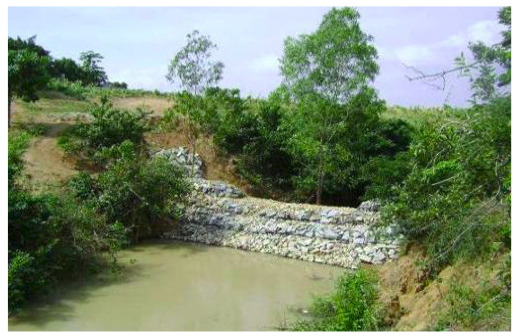Difference between revisions of "Water Portal / Rainwater Harvesting / Groundwater recharge / Leaky dams"
(→Suitable conditions) |
(→Suitable conditions) |
||
| Line 3: | Line 3: | ||
==Suitable conditions== | ==Suitable conditions== | ||
| + | {{Climate_change | ||
| + | |drought_text=- ''Effects of drought'': Less water stored behind dam. <br> - ''Underlying causes of effects'': Less recharge. <br> - ''To increase resiliency of WASH system'': Reduce water loss behind by using adjustable sheets filled with small size | ||
| + | gravel on the upstream side of the dam. | ||
| + | |||
| + | |flood_text= xxx | ||
| + | }} | ||
| + | |||
Good practice is somewhat similar to that for a [[sand dam]]. | Good practice is somewhat similar to that for a [[sand dam]]. | ||
* Ensure they are not built in an area where water will bypass the structure. Riverbanks should be equal in height and tall enough (height of dam + height of flood +10%), and dam should not be constructed near the bend in a river. | * Ensure they are not built in an area where water will bypass the structure. Riverbanks should be equal in height and tall enough (height of dam + height of flood +10%), and dam should not be constructed near the bend in a river. | ||
Revision as of 17:41, 19 April 2012
A floodwater harvesting technique, these are permeable structures built across seasonal riverbeds which retain flash flood water that has a high silt load. The idea is to retain the high-energy floods and stimulate settlement of suspended sediment behind the dam. Water with a lower sediment load is then available to leak through the dam and infiltrate the downstream riverbed which is not blocked by sediment deposits. They have been proven to be able to recharge local aquifers. Leaky dams are excellent in semi-arid areas since they greatly reduce evaporation, in regards to storing water.
Suitable conditions
| ||||||
|
|
Good practice is somewhat similar to that for a sand dam.
- Ensure they are not built in an area where water will bypass the structure. Riverbanks should be equal in height and tall enough (height of dam + height of flood +10%), and dam should not be constructed near the bend in a river.
- Site where river is narrower, so that construction is cheaper.
| Advantages | Disadvantages/limitations |
|---|---|
| - Can assist recharge of shallow wells - Can reduce salinity in groundwater |
- They can silt up and will need maintenance - Possible similar issue as with gully plugs, namely unclear land tenure can result in ownership of the structure |
Construction, operations and maintenance
Similar construction as sand dams:
- Construct wing walls to avoid erosion around edges.
- Spillway is designed for river flow, and therefore varies according to the site.
- Avoid downstream erosion of dam base by making protective slab made from more rock-filled gabions.
- Timing is important: dams should be built during the dry season, but don’t build dams too close to the rains in order to avoid dam being washed away.
The dam can be made from rocks of various sizes (boulders, cobbles, stones, large gravel) that are found in and around the riverbed. In Pakistan, rocks of 200mm diameter were used. In Balochistan, the rocks are held within wire mesh nets that are built in 5 steps to total height of 4.9 metres. The exact height of the dam will vary and depend on the riverbed topography. A reinforced concrete cut-off 1.5 metres deep with 2 metre toes on both sides of the dam ensure stability. To prevent the water behind the dam percolating too quickly, it helps to put adjustable sheets filled with small size gravel on the upstream side of the dam body (helps in cases of drought).
Water extraction
- Water that infiltrates is used as soil moisture for crops cultivated after a rainfall event.
- In Balochistan, Pakistan, pipes have been added on top of the 2nd and 4th steps which discharge surplus water downstream.
- Water can be used via shallow wells and boreholes in the area.
Costs
Costs vary, but a 5-step dam, 4.9 metres high, could cost around US$26,000 to construct.
Field experiences
A leaky dam constructed in Balochistan has a catchment area of 1.79 km2 with a storage capacity of 11,000m3.
Reference manuals, videos, and links
Acknowledgements
- CARE Nederland, Desk Study Resilient WASH systems in drought prone areas. October 2010.
- Gale, Ian, Strategies for Managed Aquifer Recharge (MAR) in semi-arid areas. UNESCO's International Hydrological Programme (IHP), 2005.


